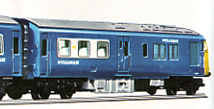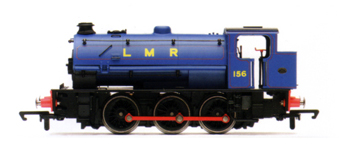Locomotive Class
Class 251 Blue Pullman
 Class: Class 251 Blue Pullman
Class: Class 251 Blue Pullman
Type: Diesel Electric
Designer: Jack Howe – Design Consultant for B.R.
Weight: 67 tons (Power Car) - 299 tons (6 Car Set) - 364 tons (8 Car Set)
Purpose: Express Passenger
Information: The Blue Pullman unit train concept was conceived as part of the 1955 Modernisation Plan in order to compete with road and air travel then taking hold of the country by providing luxury Pullman accommodation on high traffic routes on Midland and Western Regions of British Railways. Ultimately, the Pullman sets were not deemed an over-all success and services were prematurely withdrawn long before the equipment costs were amortized. However, many of the lessons learned paved the future of passenger rail travel in Britain through the success of the experimental Class 252 High Speed Train units being tested during the later period of Pullman operations.
Details: Luxury travel through Britain in trains operated by the independent Pullman Car Company had long been possible through payment of a fare supplement. At the time the Blue Pullman was conceived the fleet of Pullman coaches acquired by British Railways was dated and not in keeping with the then current Modernisation Plan put forth by British Railways for diesel hauled workings. British Railways set about correction of this problem after acquiring the Pullman Car Company by replacing the locomotive hauled stock with then current technology based on the success of the Mark 1 carriage design. In addition radical change was envisioned for the Midland and Western Regions by the introduction of dedicated multiple train units revolving around the Pullman 1st class travel concept aimed at the business traveler wanting to get from point A to B in a timely and comfortable fashion. Trains were designed around top speed travel of 90-MPH, although capable of 100-MPH operation. Air conditioning and humidity control was a first for British rail travelers of the period. Full at seat meal services were heavily promoted as a means to justify the added expense of an all new Pullman train service.
In 1956 contracts were signed with Metropolitan-Cammell to build two six-car sets for the Midland Region and three eight-car sets for the Western Region. A Design Committee set-up by British Railways and over-seen by Jack Howe closely followed the construction of the sets in the independent Metropolitan-Cammell Birmingham Works and the subsequent publicity planning.
The six-car sets allocated to the Midland Region were designated all 1st class. The eight-car sets built for the Western Region featured both 1st class and 2nd class accommodation. After a great deal of crew training, publicity, and fan-fare the trains were introduced into service between London St. Pancras and Manchester Central on the 4th of July, 1960. Western Region services commenced from London Paddington to Bristol Temple Meads later the same year, on the 12th of September.
In operation the trains did not ultimately prove to be a success. Ride quality was less than desirable, maintenance costs were high, crew requirements necessitated additional staffing; including a dedicated service engineer to maintain equipment on all trains, and route availability proved troublesome. By 1965 electrification of the Midland route and availability of new Mark 2 electric locomotive hauled Pullman stock capable of higher speeds made the Midland units redundant. They were subsequently integrated into Western Region operations.
When introduced the livery was a topical discussion. The BR design committee selected Nanking Blue as the main colour and White as an off-set for the window surrounds. Pullman crests were applied to all coach window surrounds and locomotive front fascia panels. By 1966 the front end appearance was spoiled in the eyes of many, through the addition of warning panels necessitated for visibility of track side workers through the addition of safety yellow paint forward of the drivers doors. Although topical in 1960; by 1967 the Blue & White combination no longer stood-out against the Corporate Blue & Grey image being used through-out British Rail. A decision was made to reverse the Blue & Grey while retaining the yellow cab front ends. They remained in this livery through withdrawal in 1973.
By 1973, British Railways was well along with the experimental High Speed Trains and the Mark 3 coach design. Speeds of 125-MPH were now achievable and passenger ride comfort and air conditioning was assured to all first and second class passengers with-out resorting to supplemental fares. The remaining Pullman sets were with-drawn en-masse in May 1973. After withdrawal the motor cars and rolling stock was disposed of quickly. Regrettably any talk of preservation did not materialize.
John Faulkner
Class 251 Blue Pullman Releases (5)
| MODEL | NO. | LIVERY |
|---|---|---|
| Diesel Electric Two Car Pullman | W60095 W60747 | B.R. Grey & Blue |
| Diesel Pullman Motor Car | W60095 | B.R. Blue |
| Diesel Pullman Motor Car | W60095 | B.R. Blue |
| Diesel Pullman Motor Car - Non Powered | W60097 | B.R. Blue |
| Diesel Pullman Motor Car - Non Powered | W60097 | B.R. Blue |
Class 251 Blue Pullman Images (5)

Diesel Electric Two Car Pullman W60095 W60747

Diesel Pullman Motor Car W60095

Diesel Pullman Motor Car W60095

Diesel Pullman Motor Car - Non Powered W60097

Diesel Pullman Motor Car - Non Powered W60097

















